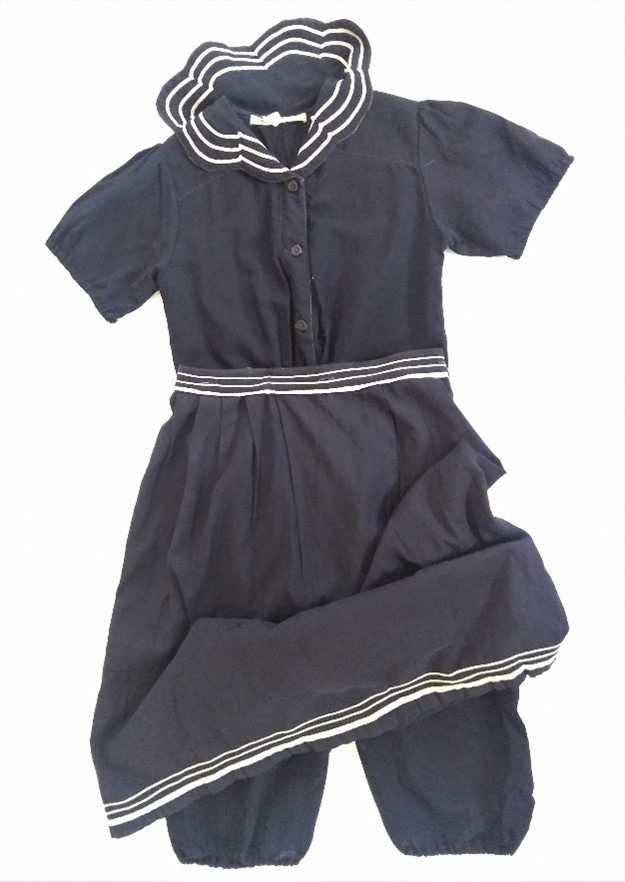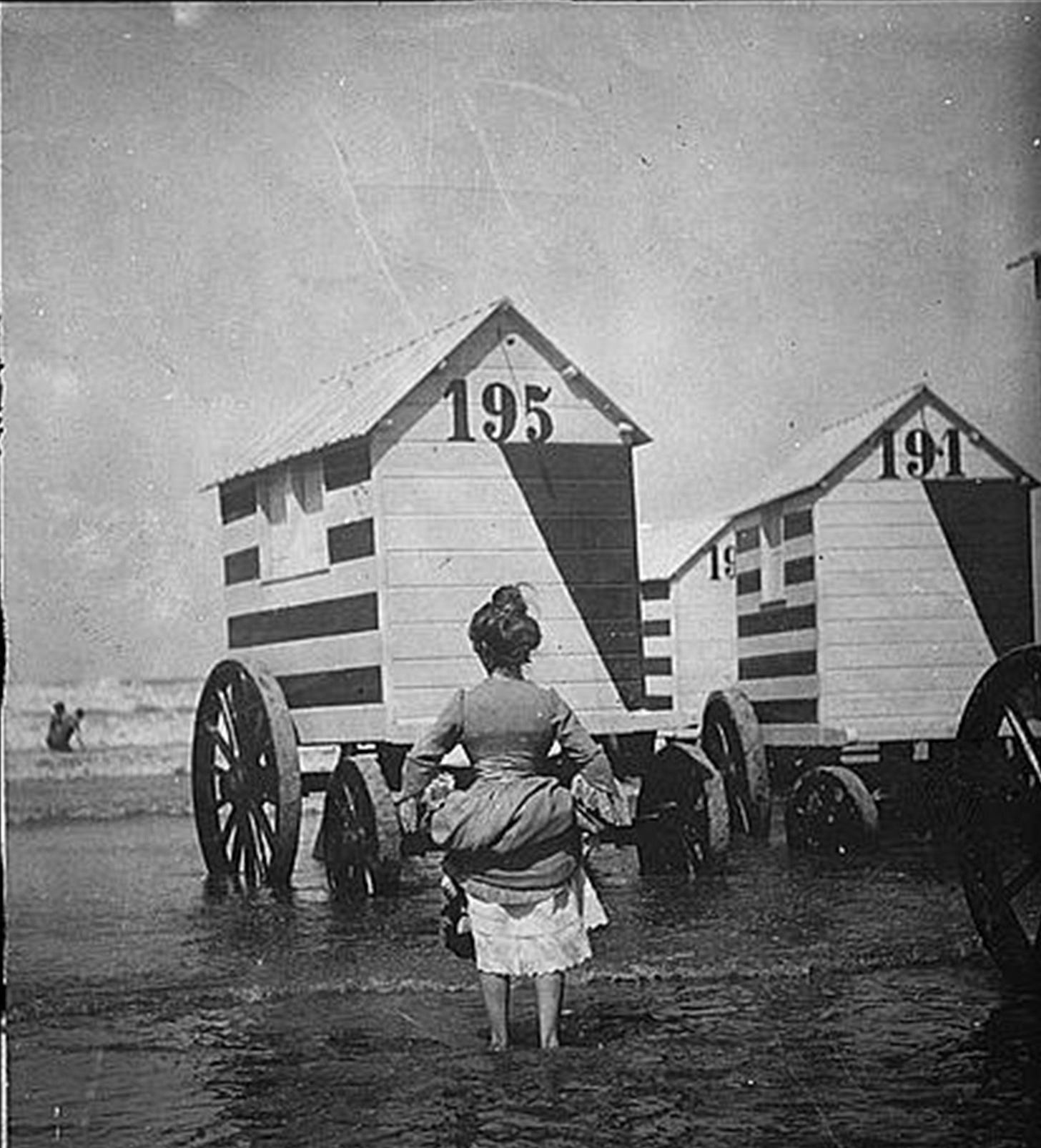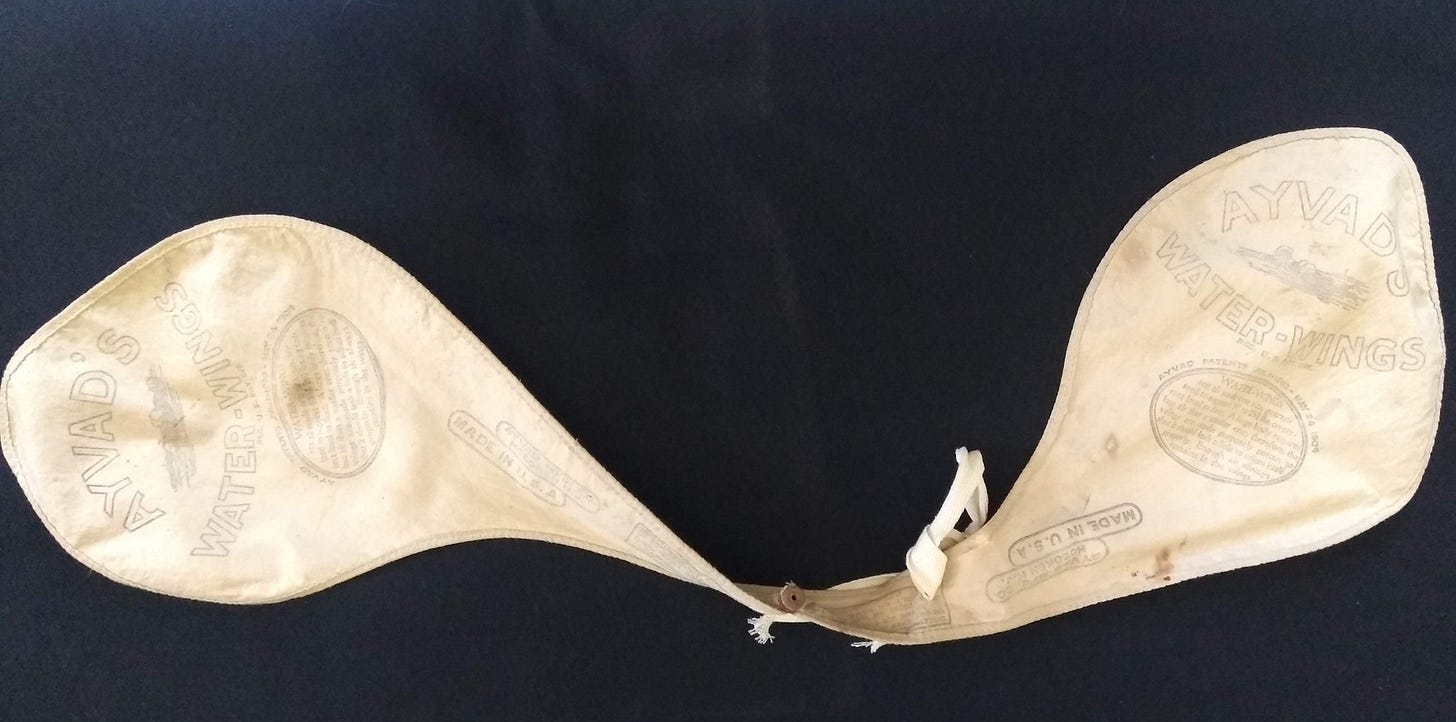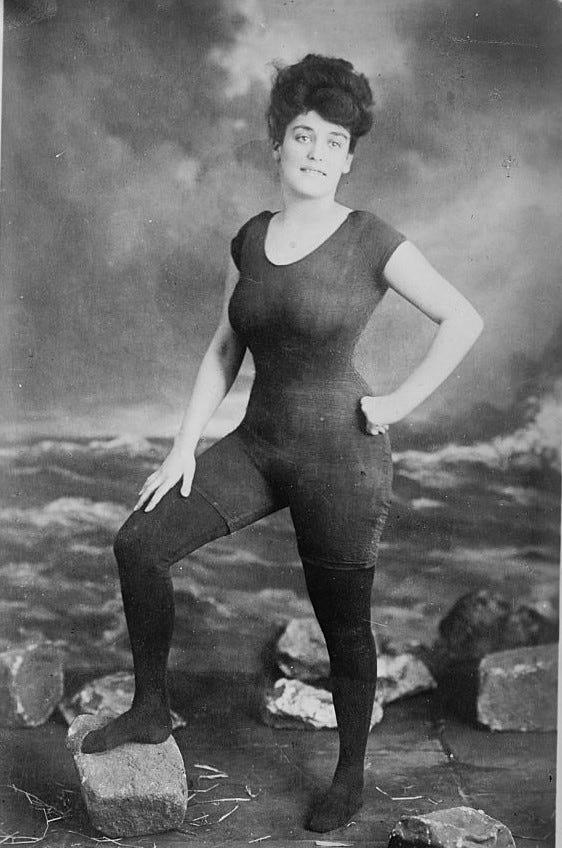What's It Wednesday - Going to the beach this weekend?
Got your swimsuit?
Maybe this isn’t what you were picturing for a day at the beach, but in the late 1890’s-early 1900s, this was the bathing suit fashion. It would have been worn with long black knit stockings and lace-up bathing slippers. The slippers were important to protect from rocky beaches.
Prior to the 18th century, it was the norm for men and women to swim in the rivers or bathe at the spas, nude. But principles of morality change. Particularly in Puritan New England and England, bathing costumes were the only “proper” way of taking the healthy benefits of bathing. In 1767, the Bath, Somerset Corporation stated that any man “shall not go into any Bath or Baths within this City by day or by night without a Pair of Drawers and a Waistcoat on their bodies.” Women had to wear “a decent Shift on their bodies.”
A bathing shift was a simple chemise usually made of wool, but sometimes of canvas, cotton or linen. The shifts were full length with long sleeves and simple necklines and they were worn with a bonnet, gloves, stockings and slippers. The gowns were over-sized so as not to reveal a woman’s body shape even when the shift was wet. Of course, the wet fabric was heavy and prevented any vigorous water activity. It was not unheard of for women to have female “ helpers” to dip the bather into the water and then help lift her out.
Particularly during the Victorian period, modesty was important. In the 1880s, bathers often used bathing machines. These were small houses on wheels. The houses were pulled by horses or men to the edge of the ocean. The house usually had a front and back door so that the bather could enter from the beach-side fully clothed, change into her bathing costume in privacy, and then emerge on the water side, in her bathing clothes. After splashing in the water, she could emerge and go back into the bath house to change, her modesty still intact.
Once it was accepted that swimming was a healthy activity that could be done without offending morality, changes in bathing costumes came quickly.
By the 1890s, the shift style gave way to a one-piece outfit with bloomers attached. It was worn with a calf-length skirt over the bloomers to add greater coverage of a woman’s figure. They were still made of wool or heavy cotton and were usually dark blue or black. The color prevented onlookers from telling if the clothing was wet. The weight of the fabric kept it from floating up and compromising a woman’s modesty.
With the turn of the 19th century came even more changes. Swimming for health and as a sport was embraced.
In 1900, as people began to flock to the beaches, inventor, H. A. Ayvad of Hoboken, NJ, realized that many people and particularly children, did not know how to swim. He began making cloth “wings” that could be inflated to help young children learn to swim. Ayvad found that the interest in his water wings was so great that he couldn’t keep up with demand. At the advice of his friends, he patented the water wing design in 1901 and started the Ayvad Manufacturing Company.
In the 1900s swimsuit styles changed to allow freer movement. Women exposed their arms; hems went up to mid-thigh. Designers used less fabric. Wool was replaced with lighter serge and knitted fabric. Styles were sleek and revealed a woman’s shape.
Annette Kellerman, “ the Australian Mermaid” had a great impact on the change in swimwear for women. She was a competitive long-distance swimmer as well as an “underwater ballerina.” She made a splash in 1905 when she refused to change her swimming outfit for a performance before the British Royal Family. Her suit was sleek and showed the bottom half of her legs. Her solution was to sew long stockings to her suit.
Two years later, when Annette was competing in Boston, she was arrested for indecent exposure. The decision was overturned when the judge ruled that heavy, ill-fitting bathing suits were impractical.
The design and production of swimwear began to take off. In 1910, the Portland (OR) Knitting Company was started by Carl C. Jantzen and John C. Zehntbauer. It was a retail store with knitting machines on the second floor where they made heavy knit sweaters and stockings that they sold. Jantzen was approached by a member of the local rowing club and asked to make knit rowing trunks. The trunks became very popular and made a name for the company. The company became the largest U.S. producer of swimwear in the 1920s. The company name was changed in 1921 to the Jantzen Knitting Company. The elastic rib stitch pattern used for the trunks and other swimwear was granted a patent that same year. Jantzen Company was the first to use the word swimsuits for bathing suits.
As the 1920s progressed, people flocked to the beaches. Sun-bathing became more accepted. Tanned skin was not just the mark of a tradesman or farmer, but provided a healthy glow. The swimsuit styles adapted to show more skin. Hollywood popularized the idea of swimwear being sexy and glamorous.
Leading up to WWII, two-piece suits entered the fashion. Still maintaining some decorum, they covered a woman’s navel, showing only a bit of midriff.
Then, in 1946 came the "Atome — the world's smallest bathing suit." a revealing two-piece swimsuit, designed by French designer Jacques Heim. The competition was on to design the smallest swimsuit. Three weeks later, Louis Réard produced the bikini, named after the island in the Pacific Ocean. The design was a first- revealing the wearer’s navel - and used a total of 16 square inches of fabric for the two pieces. In his advertising, Réard maintained that it wasn’t a bikini “unless it could be pulled through a wedding ring.”
And the rest is history!
I hope you have a great Memorial Day Weekend.
Don’t forget your swimsuit and your water wings!
Thank you for reading!
Resources:
Andover Center for History and Culture Collection
Smithsonian Institution National Museum of American History
Fashion Institute of Technology, NYC









